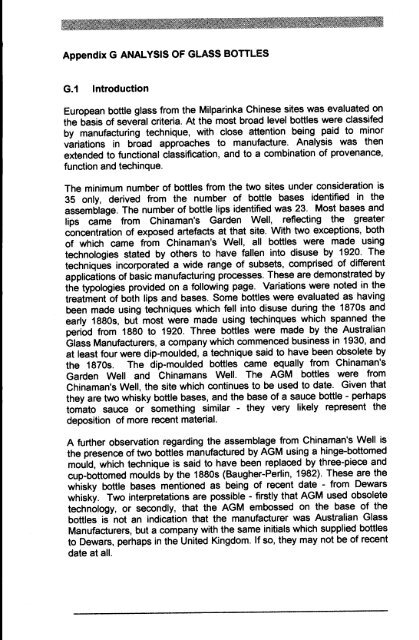Adec Preview Generated PDF File - The Sydney eScholarship ...
Adec Preview Generated PDF File - The Sydney eScholarship ...
Adec Preview Generated PDF File - The Sydney eScholarship ...
You also want an ePaper? Increase the reach of your titles
YUMPU automatically turns print PDFs into web optimized ePapers that Google loves.
Appendix G ANALVSIS OF GLASS BOTTLES<br />
G.1 Introduction<br />
European bottle glass from the Milparinka Chinese sites was evaluated on<br />
the basis of several criteria. At the most broad level bottles were classifed<br />
by manufacturing technique, with close attention being paid to minor<br />
variations in broad approaches to manufacture. Analysis was then<br />
extended to functional classification, and to a combination of provenance,<br />
function and techinque.<br />
<strong>The</strong> minimum number of bottles from the two sites under consideration is<br />
35 only, derived from the number of bottle bases identified in the<br />
assemblage. <strong>The</strong> number of bottle lips identified was 23. Most bases and<br />
lips came from Chinaman's Garden Well, reflecting the greater<br />
concentration of exposed artefacts at that site. With two exceptions, both<br />
of which came from Chinaman's Well, all bottles were made using<br />
technologies stated by others to have fallen into disuse by 1920. <strong>The</strong><br />
techniques incorporated a wide range of subsets, comprised of different<br />
applications of basic manufacturing processes. <strong>The</strong>se are demonstrated by<br />
the typologies provided on a following page. Variations were noted in the<br />
treatment of both lips and bases. Some bottles were evaluated as having<br />
been made using techniques which fell into disuse during the 1870s and<br />
early 1880s, but most were made using techinques which spanned the<br />
period from 1880 to 1920. Three bottles were made by the Australian<br />
Glass Manufacturers, a company which commenced business in 1930, and<br />
at least four were dip-moulded, a technique said to have been obsolete by<br />
the 1870s. <strong>The</strong> dip-moulded bottles came equally from Chinaman's<br />
Garden Well and Chinamans Well. <strong>The</strong> AGM bottles were from<br />
Chinaman's Well, the site which continues to be used to date. Given that<br />
they are two whisky bottle bases, and the base of a sauce bottle - perhaps<br />
tomato sauce or something similar - they very likely represent the<br />
deposition of more recent material.<br />
A further observation regarding the assemblage from Chinaman's Well is<br />
the presence of two bottles manufactured by AGM using a hinge-bottomed<br />
mould, which technique is said to have been replaced by three-piece and<br />
cup-bottomed moulds by the 1880s (Baugher-Perlin, 1982). <strong>The</strong>se are the<br />
Whisky bottle bases mentioned as being of recent date - from Dewars<br />
Whisky. Two interpretations are possible - firstly that AGM used obsolete<br />
technology, or secondly, that the AGM embossed on the base of the<br />
bottles is not an indication that the manufacturer was Australian Glass<br />
Manufacturers, but a company with the same initials which supplied bottles<br />
to Dewars, perhaps in the United Kingdom. If so, they may not be of recent<br />
date at all.




